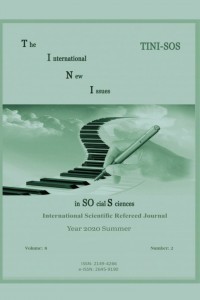ÇEVRESEL ATIK KRİTERİ TEMELLİ TEDARİKÇİ SEÇİM PROBLEMİ
Çevreci tedarikçi seçimi, Entropi, Bulanık çok amaçlı doğrusal programlama
ENVIRONMENTAL WASTE CRITERION-BASED SUPPLIER SELECTION PROBLEM
___
- Adamo, J. M. (1980). Fuzzy decision trees. Fuzzy Sets and Systems, 4(3), 207– 219.
- Amid, A., Ghodsypour, S. H., & O’Brien, C. (2006). Fuzzy multi-objective linear model for supplier selection in a supply chain. International Journal of Production Economics, 104(2), 394–407.
- Amin, S. H., Razmi, J., & Zhang, G. (2011). Supplier selection and order allocation based on fuzzy SWOT analysis and fuzzy linear programming. Expert Systems with Applications, 38(1), 334–342.
- Awasthi, A., Chauhan, S. S., & Goyal, S. K. (2010). A fuzzy multi criteria approach for evaluating environmental performance of suppliers. International Journal of Production Economics, 126(2), 370–378.
- Bai, C., & Sarkis, J. (2010). Green supplier development: Analytical evaluation using rough set theory. Journal of Cleaner Production, 18(12), 1200– 1210.
- Bellman, R. E., & Zadeh, L. A. (1970). Decision making in a fuzzy environment. Management Science, 17(4), 141–164.
- Boender, C. G. E., DeGraan, J. G., & Lootsma, F. A. (1989). Multiple-criteria decision analysis with fuzzy pairwise comparisons. Fuzzy Sets and Systems, 29(2), 133–143.
- Bozbura, F. T., Beskese, A., & Kahraman, C. (2007). Prioritization of human capital measurement indicators using fuzzy AHP. Expert Systems with Applications, 32(4), 1110–1112. 8192.
- Buyukozkan, G., & Cifci, G. (2011). A novel fuzzy multi-criteria decision framework for sustainable supplier selection with incomplete information. Computers in Industry, 62(2), 164–174.
- Buckley, J. J. (1985). Fuzzy hierarchical analysis. Fuzzy Sets and Systems, 17(3),233–247.5–17.
- Erkan, E. F., Teke, Ç. & Güleryüz, D. (2016). A Fuzzy Expert System for Risk Self
- Assessment of Chronic Diseases. IOSR Journal of Computer Engineering 18(6), 29-33.
- Freeman J., Chen T. (2015). Green supplier selection using an AHP-Entropy- TOPSIS framework. Supply Chain Management: An International Journal, Vol. 20 Iss: 3, pp.327 – 340.
- Gao, Z., & Tang, L. (2003). A multi-objective model for purchasing of bulk raw materials of a large-scale integrated steel plant. International Journal of Production Economics, 83(3), 325–334.
- Ghodsypour, S. H., & O’Brien, C. (1998). A decision support system for supplier selection using an integrated analytic hierarchy process and linear programming. International Journal of Production Economics, 56–57(1), 199–212.
- Handfield, R., Walton, S., Sroufe, R.,&Melnyk, S. (2002). Applying enviromental criteria to supplier assessment: A study in the application of the analytical hierarchy process. European Journal of Operational Research, 141(1), 70–87.
- Hong, G. H., Park, S. C., Jang, D. S., & Rho, H. M. (2005). An effective supplier selection method for constructing a competitive supply-relationship. Expert Systems with Applications, 28(4), 629–639.
- Hsu, C. W., & Hu, A. H. (2009). Applying hazardous substance management to supplier selection using analytic network process. Journal of Cleaner Production, 17(2), 255–264.
- Kuo, R. J., Wang, Y. C., & Tien, F. C. (2010). Integration of artificial neural network and MADA methods for green supplier selection. Journal of Cleaner Production, 18(12), 1161–1170.
- Lu, Y. Y., Wu, C. H., & Kuo, T. C. (2007). Environmental principles applicable to green supplier evaluation by using multi-objective decision analysis. International Journal of Production Research, 45(18–19), 4317–4331.
- Shaw, K., Shankar, R., Yadav, S., Thakur, L. (2012). Supplier selection using fuzzy AHP and fuzzy multi-objective linear programming for developing low carbon supply chain. Expert Systems with Applications, 39(9), 8182- 8192.
- Tiwari, R. N., Dharmahr, S., & Rao, J. R. (1987). Fuzzy goal programming-an additive model. Fuzzy Sets and Systems, 24(1), 27–34.
- Zimmermann, H. J. (1978). Fuzzy programming and linear programming with several objective functions, Fuzzy Sets and Systems, 1(1), 45–55.
- ISSN: 2149-4266
- Yayın Aralığı: Yılda 2 Sayı
- Başlangıç: 2015
- Yayıncı: Orhan KÜÇÜK
YÜKSELEN EKONOMİLERDE LOJİSTİĞİN BELİRLEYİCİLERİ©
Dilek ÖZDEMİR, Özge BUZDAĞLI, Ö Selçuk EMSEN, Mehmet SOLAK
Mustafa BAYHAN, Mevhibe TÜRKMEN
LOJİSTİK SEKTÖRÜNDE ÇALIŞAN PERSONELİN İLETİŞİM BECERİLERİNİN İNCELENMESİ
İlke Sezin AYAZ, Esra BARAN, Ramzan Özkan YILDIZ
Adem ÜZÜMCÜ, Samet TOPAL, Murat AKÇA
Sena AYDOĞAN, Murat ŞAHİN, İsmet SÖYLEMEZ
LOJİSTİK FAALİYETLERDE MODERN STOK YÖNETİM MODELLERİNİN UYGULANABİLİRLİĞİ
Dilşad GÜZEL, Fatma Gül YAZICILAR, Selin AYKOL
AB-28 ÜLKELERİNDE ULAŞIM SEKTÖRÜ VE ULUSLARARASI TİCARET LOJİSTİĞİNİN AĞ ANALİZİ İLE İNCELENMESİ
Semanur SOYYİĞİT, Şerafettin KELEŞ, Aslı Cansın DOKER
FORWARDER ÇALIŞANLARININ ÖRGÜTSEL BAĞLILIĞI: İZMİR İLİNDE BİR ARAŞTIRMA
TÜRKİYE'DE DIŞ TİCARET VE LOJİSTİKTE YENİ FIRSATLAR VE HEDEFLER
Fehim BAKIRCI, Abdullah TAKIM, Abdullah TÜZEMEN
